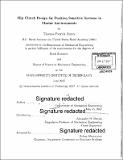| dc.contributor.advisor | Alexander H. Slocum. | en_US |
| dc.contributor.author | Finley, Thomas Patrick | en_US |
| dc.contributor.other | Massachusetts Institute of Technology. Department of Mechanical Engineering. | en_US |
| dc.date.accessioned | 2017-10-18T15:08:57Z | |
| dc.date.available | 2017-10-18T15:08:57Z | |
| dc.date.copyright | 2017 | en_US |
| dc.date.issued | 2017 | en_US |
| dc.identifier.uri | http://hdl.handle.net/1721.1/111894 | |
| dc.description | Thesis: Nav. E., Massachusetts Institute of Technology, Department of Mechanical Engineering, 2017. | en_US |
| dc.description | Thesis: S.M., Massachusetts Institute of Technology, Department of Mechanical Engineering, 2017. | en_US |
| dc.description | Cataloged from PDF version of thesis. | en_US |
| dc.description | Includes bibliographical references (pages 133-134). | en_US |
| dc.description.abstract | The Naval Research Laboratory (NRL) requested a two-axis pan tilt mechanism be designed, built, and tested for shipboard deployment of a sensor payload. Of paramount consideration to this design was the robustness of the system in the face of wave impact loading from "green water" taken over the superstructure of naval vessels. Central to providing such a system is the prevention of drive train failures given wave or other forms of impact loading. Through the course of work completed for his Master's thesis, Nathan M. Mills brought the design effort through initial bench testing. Several failures were experienced due to minor design flaws and mechanical component selection. One component selection that required improvement was the torque limiting slip clutch used in both the pan and tilt drive sections. The unit selected induced positioning errors resulting from backlash inherent to its design. The backlash encountered is unavoidable when using the type of slip clutch selected, as it is with many of the slip clutches available to the machine designer. Slip clutches are available that have limited backlash, but the majority of these are friction based and have setpoints that either do not have tight tolerances or change as the component is cycled. The goal of the present work was to design a slip clutch that maintains its setpoint and minimizes backlash to allow for its shipboard use in the NRL sponsored pan tilt system. The design was completed in a manner that supports the use of the slip clutch in other systems that require accurate positioning and torque overload protection in both marine and non-marine environments. | en_US |
| dc.description.statementofresponsibility | by Thomas Patrick Finley. | en_US |
| dc.format.extent | 134 pages | en_US |
| dc.language.iso | eng | en_US |
| dc.publisher | Massachusetts Institute of Technology | en_US |
| dc.rights | MIT theses are protected by copyright. They may be viewed, downloaded, or printed from this source but further reproduction or distribution in any format is prohibited without written permission. | en_US |
| dc.rights.uri | http://dspace.mit.edu/handle/1721.1/7582 | en_US |
| dc.subject | Mechanical Engineering. | en_US |
| dc.title | Slip clutch design for position sensitive systems in marine environments | en_US |
| dc.type | Thesis | en_US |
| dc.description.degree | Nav. E. | en_US |
| dc.description.degree | S.M. | en_US |
| dc.contributor.department | Massachusetts Institute of Technology. Department of Mechanical Engineering | |
| dc.identifier.oclc | 1005079578 | en_US |
